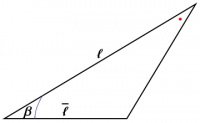The 2-momentum of an object in (2-dimensional) Minkowski space moving at speed $v=\tanh\beta$ is given by \begin{equation} \bp = m\,\bu = \begin{pmatrix} E \\ p \\ \end{pmatrix} = \begin{pmatrix} m\,\cosh\beta \\ m\,\sinh\beta \\ \end{pmatrix} \end{equation} Consider $N$ equally-spaced identical particles, as shown in Figure 1, and in a spacetime diagram in Figure 2. If the separation between particles in their rest frame is $\ell$, then the number density of particles in their rest frame is \begin{equation} n = \frac{N}{\ell} \end{equation} As shown in Figure 3, an observer at rest watching the particles go past will measure \begin{equation} \bar\ell = \frac{\ell}{\cosh\beta} \end{equation} due to length contraction, and will therefore observe a number density \begin{equation} \bar{n} = n\,\cosh\beta \end{equation} How many such particles move past an observer at rest per unit time? The distance traveled by each particle is $v\cdot1=\tanh\beta$, so the number flux of particles is given by \begin{equation} \bar{n}\,\tanh\beta = n\,\sinh\beta \end{equation} This leads us to define the number flux 2-vector \begin{equation} \bN = n\,\bu = \begin{pmatrix} n\,\cosh\beta \\ n\,\sinh\beta \\ \end{pmatrix} \end{equation} where $n$ is the number density of the particles in their rest frame.
The energy density of the particles is just their number density times the mass of each particle. Thus, in the rest frame of the particles, the energy density is just $mn$, whereas an observer at rest (i.e. moving with respect to the particles with $v=\tanh\beta$) would observe an energy density of \begin{equation} \bar{m}\bar{n} = mn\,\cosh^2\beta \end{equation} The energy density therefore transforms with two factors of $\cosh\beta$, rather than one, so that it is not the component of a vector. Rather, it is the component of a rank 2 object, the stress-energy-momentum tensor $T$, usually referred to as either the stress tensor or the energy-momentum tensor. Our previous discussion correctly suggests that the energy-momentum tensor for our collection of particles (“dust”) should be given by some sort of product of the vectors $\bp$ and $\bN$, and the correct answer turns out to be \begin{equation} T = \bp \otimes \bN \end{equation} where the symbol $\otimes$ means the tensor product, and is read as “tensor”. All this means is that the new object $T$ has components $T^{ij}$ that are given by \begin{equation} T^{ij} = p^i N^j = mn\,u^i\,u^j \end{equation} Note that the matrix of components $(T^{ij})$ is symmetric; $T$ is called a symmetric (rank 2, contravariant) tensor.
We choose to avoid further discussion of the tensor nature of $T$ by using instead a physically equivalent description in terms of vector-valued differential forms. Consider the energy-momentum 1-forms defined by \begin{equation} T^i = T^i{}_j\,\sigma^j \end{equation} where $T^i{}_j$ is (of course!) obtained from $T^{ij}$ by lowering an index with the metric, that is \begin{equation} T^i{}_j = g_{jk} T^{ik} = T^{ik} \ee_k\cdot\ee_j = \pm T^{ij} \end{equation} Then we can think of the energy-momentum tensor as a vector-valued 1-form, denoted by $\Tvec$, which is given by \begin{equation} \Tvec = T^i \ee_i \end{equation}


